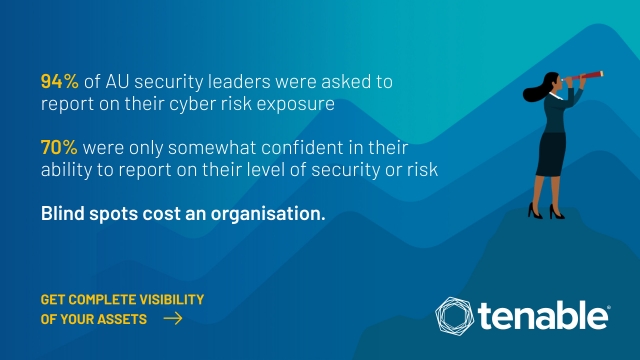- I found a Bluetooth tracker for Android users that works better than AirTags (and is cheaper)
- Learn with Cisco at Cisco Live 2025 in San Diego
- This Eufy robot vacuum has a built-in handheld vac - and just hit its lowest price
- I highly recommend this Lenovo laptop, and it's nearly 50% off
- Disney+ and Hulu now offer prizes, freebies, and other perks to keep you subscribed
Australian Business Leaders Prepare for Incoming Cyber Regulation by Demanding Greater Cyber Visibility

But 70% of security leaders struggle to report on their level of exposure – new industry survey finds
Tenable®, Inc., the Cyber Exposure company, has published a new study that reveals 94% of Australian security leaders report they have been asked by top executives to report on their organisation’s level of exposure to a specific threat or publicised vulnerability, yet 70% are only somewhat confident, at best, in their ability to report on their level of security or risk when asked.
Coinciding with Australia’s Cyber Security Strategy 2020, this study indicates that business leaders of critical infrastructure and systems of national importance may be subject to potential regulatory penalties if they don’t equip security teams with the right tools to measure and communicate cyber risks; this is a clarion call for business and security leaders in Australia to align on cyber imperatives.
The self-reported data are drawn from the Australian instalment of ‘The Rise of the Business-Aligned Security Executive.’ The commissioned study of 105 business and cybersecurity leaders in Australia was conducted by Forrester Consulting on behalf of Tenable. Despite increased focus and investment in cybersecurity, the study found that 92% of Australian organisations experienced a business-impacting cyberattack in the past 12 months. Roughly three quarters of these attacks (73%) involved operational technology (OT) assets. Some of these business-impacting attacks came in the form of fraud (45%), Covid-19 phishing incidents (44%), data breaches (43%), ransomware (39%), and software vulnerabilities (36%).
The study also found that 67% of business leaders report that their security counterparts are, at best, only “somewhat effective” in communicating threats that pose the greatest risk to the organisation. This finding coupled with the onslaught of business-impacting cyberattacks questions the level of visibility organisations have into their most critical assets to make risk reduction decisions.
“It’s encouraging that many Australian business leaders are prioritising cybersecurity as a critical business function. In order for executives to make appropriate risk-informed decisions, security leaders must be able to communicate cyber risk in business terms. Failure to do so will surely result in further business-impacting attacks with the possibility of impending regulatory penalties,” Scott McKinnel, ANZ Country Manager, Tenable.
Equipping security leaders with the tools to succeed
The study highlights three key areas of improvement in order for security leaders to more effectively communicate cyber risk to executives:
- Holistic visibility of business-critical assets: Security leaders reported that they have limited visibility over important company assets. Only six out of 10 security leaders say they have ‘high or complete visibility’ into their organisations’ IoT and operational technology (OT); 47% are aware of the risk posed to employees working remotely or from home; and only 30% have visibility over third-party vendors. As a result, few security leaders have a holistic understanding of their organisations’ modern attack surface.
- Security metrics that speak to business risk: Just four out of 10 Australian security leaders say they work with business stakeholders to align cost, performance, and risk reduction objectives with business needs. Fewer than 50% state that they use contextual threat metrics to measure their organisations’ cyber risk.
- Predictive business risk context for incoming threats: 40 percent of Australian security leaders aren’t confident that they have the technology, processes or data to predict cybersecurity threats. This could, in part, be due to a lack of automation technologies since three out of 10 security leaders say their organisations still manually review spreadsheets to track cybersecurity performance.
“Crucially, this research highlights that a lack of visibility is undermining security leaders’ ability to analyse and combat cyber risks, whilst most security and business leaders aren’t working together to align security and business performance metrics. To effectively manage an organisation’s strategic approach to cyber risk, Australian security leaders should be using risk metrics, cost and performance indicators – the language executives understand,” said McKinnel.
-ENDS-
Note to Editors:
- Forrester Consulting conducted an online survey of 416 security and 425 business executives, as well as telephonic interviews with five business and security executives, to examine cybersecurity strategies and practices at midsize to large enterprises in Australia, Brazil, France, Germany, India, Japan, Mexico, Saudi Arabia, the UK and the US. The study was fielded in April 2020.
- “Business-impacting” relates to a cyberattack or compromise that results in a loss of customer, employee, or other confidential data; interruption of day-to-day operations; ransomware payout; financial loss or theft; and/or theft of intellectual property.
To read the full study, visit: here
About Tenable
Tenable®, Inc. is the Cyber Exposure company. Over 30,000 organizations around the globe rely on Tenable to understand and reduce cyber risk. As the creator of Nessus®, Tenable extended its expertise in vulnerabilities to deliver the world’s first platform to see and secure any digital asset on any computing platform. Tenable customers include more than 50 percent of the Fortune 500, more than 30 percent of the Global 2000 and large government agencies. Learn more at www.tenable.com.
Contact Information:
Pamela Philip
Tenable
[email protected]
+61 478 701 734

